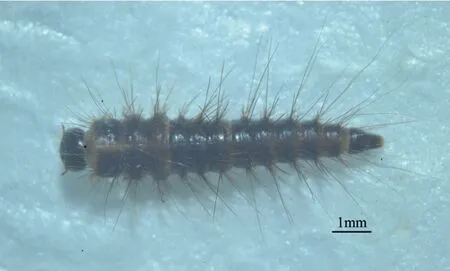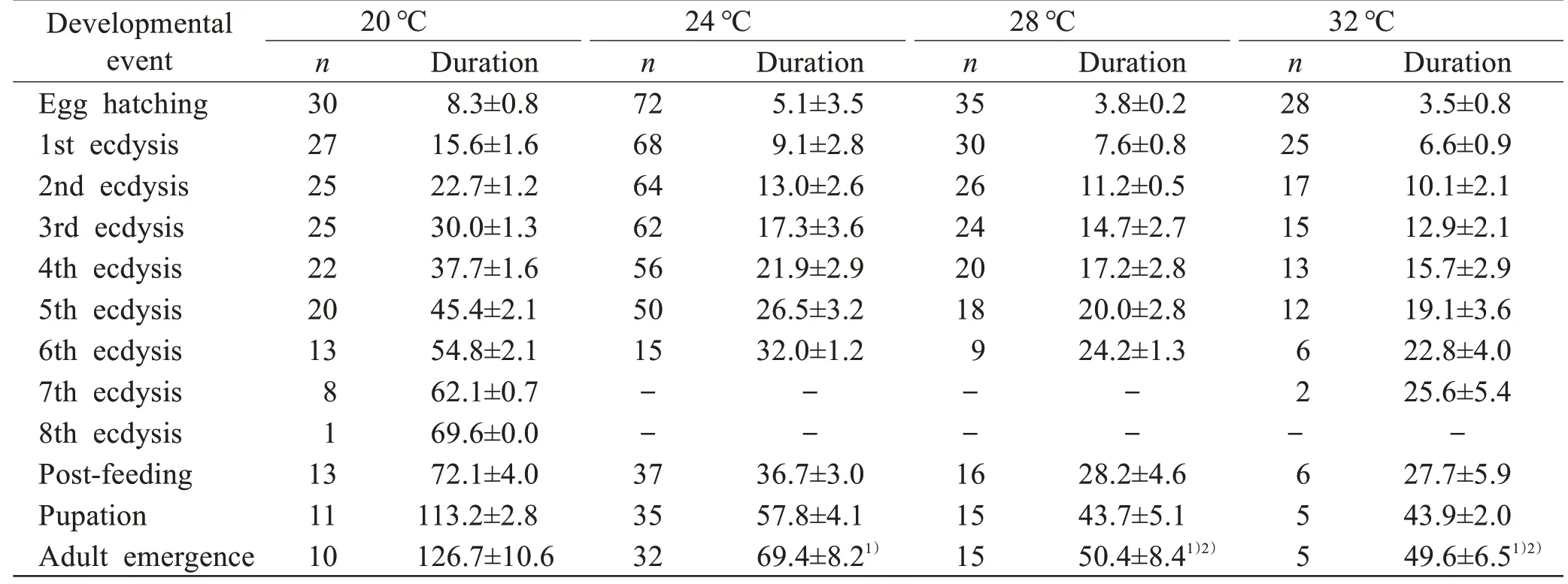Development of Dermestes Maculatus at a Constant Temperature and Its Larval Instar Determination
LI Liang-liang ,WANG Yu,LI Xue-boZHANG Jia-shuoWANG Jiang-feng
1.Key Laboratory of Evidence-Identifying in Universities of Shandong,Shandong University of Political Science and Law,Jinan 250014,China;2.Department of Forensic Medicine,Soochow University,Suzhou 215000,Jiangsu Province,China
Abstract: Objective To establish the basic data for estimating minimum postmortem interval(PMImin)of heavily decayed and skeletonized remains by studying the development of Dermestes maculatus DeGeer(Coleoptera:Dermestidae). Methods The developmental stages of Dermestes maculatus were observed at four constant temperatures of 20 ℃,24 ℃,28 ℃and 32 ℃,and the changes in body length were also examined as the biological indicator to estimate larval day-age and instar. Results The total developmental time from egg to adult at 20 ℃,24 ℃,28 ℃ and 32 ℃ were(126.7±10.6)d,(69.4±8.2)d,(50.4±8.4)d and(49.6±6.5)d,respectively.The body length increased gradually,but changed irregularly as a whole. Conclusion The study provides basic data on the development and growth of Dermestes maculatus,especially on its developmental duration as a significant value for estimating PMImin of heavily decayed and skeletonized remains.Nevertheless,the change of body length is not found to be the best biological indicator for instar determination.
Keywords:forensic entomology;skeletonized remains;minimum postmortem interval;instar determination; Dermestes maculatus
Introduction
Dermestes maculatusDeGeer(Coleoptera,Dermestidae;herein after referred to asD.maculatus),also known as the hide beetle,is a carrion beetle and cosmopolitan pest that damages stored products,as they prefer dry and protein-rich organic matter[1-4].It occasionally acts as intermediate hosts of parasites or as vectors of disease,causing allergic reactions[5],and even attacks and eats live turkeys[6].Despite its causing harms,D.maculatusis the species typically used by universities and museums to remove flesh from bone in skeleton preparation[7-9].D.maculatusis also a forensically important species to be found in insect succession studies and case reports[10-15],often found during the dry stage of decomposition where large numbers of larvae and adults develop when the corpse has only skin,hair and bone left[15-17].Though the most common application of forensic entomology is based on the development of the earliest arriving species of blowflies(family:Calliphoridae),the minimum postmortem interval(PMImin)estimation is less inaccurate once blowfly adults emerge and leave the corpse.Therefore,the development of this species is of great importance to the estimation of PMIminof skeletonized and mummified remains having a long PMI.
The larval instar of Diptera can be easily determined by checking the number of openings in the posterior spiracles,and PMImincan be accurately estimated for the species with larval instar or body lengths measurements[18].However,most forensically significant beetle larvae lack morphological features which are specific to developmental stages or particular instars,making the larval instar determination of Coleoptera,includingD.maculatus,difficult to differentiate[19].Resent studies onD.maculatusmainly center on biological characteristics,such as behavior[20],reproduction[21-23],and effect of diet and refugia on development[24].Though the developmental stages ofD.maculatushave been well studied[5,25-28],developmental data are needed to accurately determine the larval stages,such as instar classifiers and changes in larval body length.
In this study,we observed the developmental stages ofD.maculatusat four constant temperatures of 20 ℃,24 ℃,28 ℃ and 32 ℃,and also measured the changes of body lengths.Our research aimed to investigate the developmental duration ofD.maculatus,examining whether the body length could be used to determine day-age or instar for PMIminestimation of corpses in the late stages of decomposition.
Materials and methods
Colony establishment
Forty-fiveD.maculatusadults were collected from pig carcasses in a field-based insect succession study in Panyu,Guangzhou,China(22°45' N,113°14' E)during late spring of 2010.The adults were placed in a rearing box(323 mm×220 mm×100 mm)with a window(30 mm×50 mm)made of nylon mesh in the center of the lid for ventilation.A Zeiss stemi 2000-C stereo stereomicroscope(Carl Zeiss AG,Germany)was used to visually verify species characteristics based on the identification keys of ZHANGet al.[29]The collected insects were all identified asD.maculatusDeGeer.The pork sausage,prepared using pure pork from the market,were sliced 6 cm in diameter and 2 mm thick to be placed in the rearing box for the adults and oviposition media.Before feeding,the pork sausage was exposed under the sun,with the additional grease wiped off to avoid death of younger larvae from being glued and restrained by the grease.The eggs oviposited on the sausage were picked out carefully using a soft brush before placed into a new rearing box.When larvae hatched,sufficient food was provided until pupation.Newly emerged adults were removed to be placed in new insectrearing boxes to protect the developing pupae.The entire process was repeated to establish a colony containing over 100 adults.
Animal care approval was received from the Ethics Committee of Soochow University(ECSU-20190000109).
Investigation of developmental stages
The eggs laid within 2 hours(n=1-57)were picked out and placed into a culture dish containing food.The dish was placed into a rearing box,and then cultured in a microenvironment incubator at 4 constant temperatures of 20 ℃,24 ℃,28 ℃and 32 ℃,with 50%-60% humidity and a light-dark cycle of 12 h light and 12 h dark.A piece of thick black paper was placed on the top of the box,creating a comparatively dark environment for the beetles.The eggs were observed every 2 hours,and the larvae and pupae,twice a day.The pork sausage slices were replenished as needed.The time points of hatching,ecdysis,pupation,and adult emergence were recorded during the experiment.The ecdysis was determined by checking the number of exuviate in the rearing boxes.Each experiment was repeated 4,5,3 and 4 times under 20 ℃,24 ℃,28 ℃and 32 ℃,respectively.Two different incubators LHP-300H(Yingmin Co.Ltd,Suzhou,China)were applied to each experimental temperature.
Larval sampling and morphometric indicator measurement
The eggs ofD.maculatuswere collected and reared as above.After hatching,2-3 larvae were sampled daily until pupation,and larval instar was recorded.If there were insufficient number of larvae for sampling prior to pupation,multiple clones were combined for sampling.Sampled larvae were preserved in 75% alcohol.
Larval body length was measured using a digital vernier caliper(Sangon Biotech,Shanghai,Co.,Ltd.)at a precision of 0.01 mm(Fig.1).

Fig.1 The criteria of the body length measurement
Statistical analysis
The duration of various developmental stages was analyzed by one-way analysis of variance and least significant difference(LSD)test using SPSS 14.0(IBM,USA),andα=0.05 was taken as the standard of test.
Results
Developmental duration of D.maculatus
The developmental rate ofD.maculatusincreased at higher temperatures.The overall developmental duration decreased from(126.7±10.6)d at 20 ℃to(49.6±6.5)d at 32 ℃;there was a significant effect of temperature on the developmental rate(P<0.05),as indicated by the results of the multiple comparisons in Tab.1.However,no significant difference was observed between 28 ℃ and 32 ℃ on the day of adult emergence according to the LSD test(P=0.871).The egg stage was found to be the shortest stage,lasting 6.55%-7.54% of the total duration of development,while the feeding larval stage,the longest which comprised 45.97%-53.12% of the total duration of development(Tab.2).
Tab.1 Duration for each developmental event of D.maculatus at 4 constant temperatures (,d)

Tab.1 Duration for each developmental event of D.maculatus at 4 constant temperatures (,d)
Note:The initial numbers of eggs,observed at 20 ℃,24 ℃,28 ℃and 32 ℃,were 71,152,87 and 50,respectively.‘-’,no data.1)Compared to adult emergence day under 20 ℃with LSD test, P<0.05;2)Compared to adult emergence day under 24 ℃with LSD test, P<0.05.

Tab.2 Duration of each developmental stage as a percentage of the total time from oviposition to adult emergence in D.maculatus at 4 constant temperatures (%)
Intriguingly,the number of ecdysis was different even under the same temperature,with 6-9th,5-7th,6-7th and 7-8th ecdysis observed under 20 ℃,24 ℃,28 ℃and 32 ℃,respectively.
The data of body length change
The longest body length at 20 ℃,24 ℃,28 ℃and 32 ℃was(13.08±0.37),(14.18±0.02),(13.69±0.62)and(12.28±0.23)mm,respectively.The overall trend of the larval body length before reaching the post-feeding larval stage produced a gradual increase,but changed irregularly.After entering into the post-feeding stage,the change of body length fluctuated without any specific pattern(Tab.1 in appendix).
Discussion
Our findings,which corroborated the previously published results[5,25-28],showed that the overall developmental stages ofD.maculatusfrom egg to adult were longer than those of carrion flies,which are often used to estimate PMImin.The larval stage constitutes over 70% of theD.maculatusimmature stages[5],and the precise instar determination of larvalD.maculatusis valuable for estimating PMIminof remains with longer PMI.
In forensic entomology,different measuring methods are usually used to evaluate the changes in larval body length.As to the reliability of this practice,BUGELLIet al.[30]conducted a comparative study to examine the influence of different measuring methods on the accuracy of larval age estimation,the results showing that there were no significant differences in the measurement of larval body length;this supports the view that a simple tool like a geometrical micrometer can produce reliable results in forensic entomology.In the current study,we used a more reliable digital vernier caliper at a precision of 0.01mm to measure the larval body length ofD.maculatus,which consequently confirmed the reliability of our data.The body length began to increase gradually,but as a whole changed in an irregular way.Thus the change of body length cannot be the useful biological indicator for instar determination,as in the case of the species ofOxelytrum discicolle(Brullé)[31],Necrodes surinamensis(Fabricius),Oiceoptoma inaequale(Fabricius)[32].Moreover,FRĄTCZAKet al.[19]found that the most useful features for instar determination ofNecrodes littoralisandCreophilus maxillosusdid not include body length.
The length of development inD.maculatusfrom egg to adult was longer in our study than in other previously reported ones[5,22-24],which may have been caused by the absence of suitable pupation sites for the post-feeding larvae,such as corks.D.maculatuspost-feeding larvae may have had a significantly longer post-feeding period and longer developmental stage while searching for a pupation site.MARTÍN-VEGAet al.[5]showed that the postfeeding larval stage ofD.maculatuscomprised 10% of total development time.In contrast,we found that the post-feeding stage represented approximately 30% of total development time.Our findings,however,were similar to those which had been reported by the study[5]on all other developmental stages.
Not in the case of other sarcosaphagous beetles larvae,such as rove beetles(Staphylinidae)and carrion beetles(Silphidae),we found that the ecdysis frequency ofD.maculatuslarvae was inconsistent(over 6 times)and varied significantly;this variation in instars was consistent with the results from ZANETTIet al.[25]and MARTÍN-VEGAet al.[5]Previous studies have found that the frequency of ecdysis could be influenced by temperature,humidity,light and food[33].However,ecdysis frequency can still differ among different individuals,even under rigorously controlled conditions,which suggests that ecdysis frequency could be genetically determined[25].Future studies are needed to focus on larvae separation by groups at a high and low ecdysis frequency to conduce a genomic scan for genes that may underlie this trait,which would further clarify whether genes frequently regulate ecdysis.
Acknowledgements
This research was supported by Key Laboratory of Evidence-Identifying in Universities of Shandong(Shandong University of Political Science and Law)(2018KFKT7);National Natural Science Foundation of China(31872258,32070508);Natural Science Foundation of Shandong Province(ZR2020QH288);Sichuan Medical Law Research Center(YF19-Q16).

